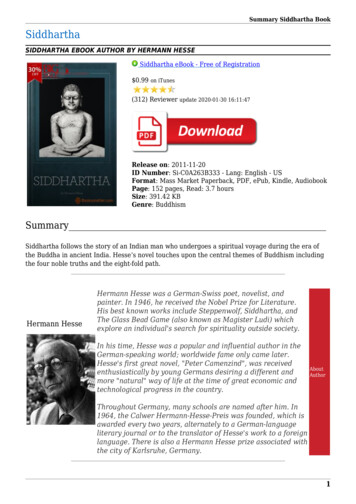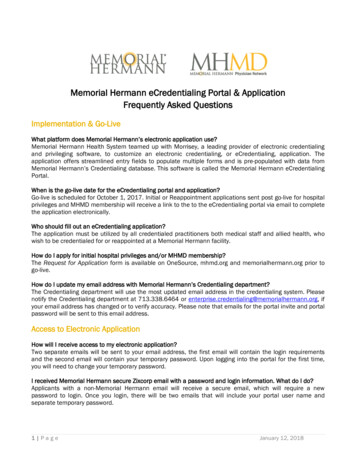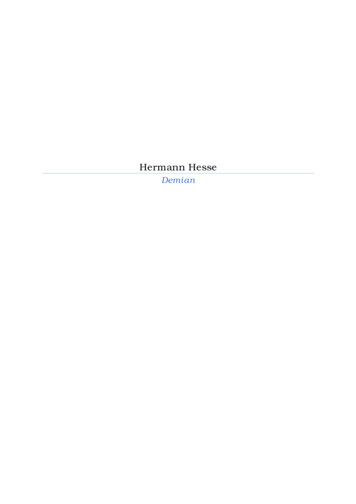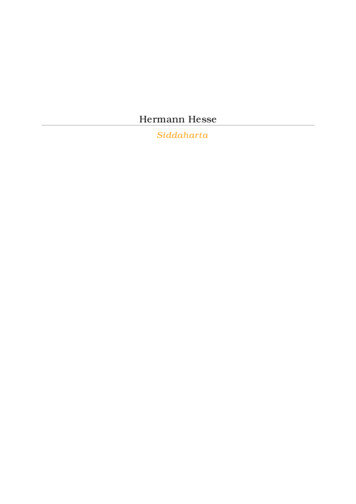
Transcription
SamplePrestwick HouseMultiple CriticalPerspectives Prestwick HouseTeaching Hermann Hesse’sSiddharthafrom Multiple Critical PerspectivesClick hereto learn moreabout thisMultiple CriticalPerspectives! Click hereto find moreClassroom Resourcesfor this title! Prestwick HouseMore from Prestwick HouseLiteratureLiterary Touchstone ClassicsLiterature Teaching UnitsGrammar and WritingCollege and Career Readiness: WritingGrammar for WritingVocabularyVocabulary Power PlusVocabulary from Latin and Greek RootsReadingReading Informational TextsReading Literature
Multiple CriticalPerspectivesTeaching Hermann Hesse'sSiddharthafromMultiple Critical Perspectives byEva Richardson
Multiple CriticalPerspectivesSiddharthaGeneral Introduction to the WorkIntroduction to SiddharthaSiddhartha is a novelabout the son of a Hindu Brahmin who searches for enlightenment. The novelcontains elements of both the Bildungsroman (novel of formation) and the allegorical novel.All novels rely on certain conventional elements, including plot (Siddhartha leaves his family insearch of enlightenment and existential answers. He adopts an ascetic lifestyle, but soon decides todedicate his life to developing an awareness of his senses. He turns to hedonistic pleasures and a materialistic city lifestyle. Ultimately, Siddhartha finds peace and enlightenment as a ferryman) and character (Siddhartha is the main character in the novel. His development stands at the core of the novel.Siddhartha can be considered a dynamic character, because he changes over the course of the novel as aresult of his experiences outlined in the plot. Other characters with whom Siddhartha interacts includehis friend Govinda, the Buddha Gotama, the courtesan Kamala, and the ferryman Vasudeva).Another significant element of the novel is setting, or time and place. (Siddhartha is not a historicalnovel, so determining a definite timeframe is difficult. Based on the novel’s characters, we can generallyassume that Siddhartha is set in India around 500 B.C.E., the time during which the historical Buddhalived and taught.) The point of view from which a novel is told determines the style and tone of the text.(Siddhartha is told from the perspective of a third-person narrator. This third-person narrator conveys theplot from Siddhartha’s perspective.) The style and tone of a novel are further established through wordchoice and sentence structure. (The sentence structure and word choice of Siddhartha produce a lyricaleffect. The novel is, therefore, often referred to as a lyrical novel.)Novels often convey one or more themes (Some of the significant themes in Siddhartha are the searchfor enlightenment, the meaning of time, the role of teachers, etc.) Several elements of a Bildungsromanare present in Siddhartha. A Bildungsroman usually involves the main character’s long and strenuousdevelopment from childhood or ignorance to adulthood or experience and maturity. (Siddharthabegins his quest as a young man. He undergoes a number of experiences throughout his life that teachhim how to seek and ultimately find enlightenment. In his old age, he eventually finds solace and contentment as a ferryman.) The development of the main character often focuses on his or her psychological, social, and personal development.In a typical Bildungsroman, the hero embarks on a journey that will lead him away from his familiarsurroundings in his quest for experience because he is disillusioned or dissatisfied with the life he hasknown thus far. (Siddhartha leaves the home of his father and mother in order to find his own place inthe world. He does not consider the life of a Brahmin to be a satisfactory route to enlightenment.)6Pr e s t w i c kHo u s e,In c.
SiddharthaMultiple h Applied to SiddharthaNotes on the Mythological/Archetypal ApproachMythological, archetypal, and psychological criticismsareall very closely interrelated. This is because Freud formulatedmany theories around the idea of the social archetype, and his pupil,Carl Jung, expanded and refined Freud’s theories into a more crosscultural philosophy.Critics who read texts with the mythological/archetypal approachare looking for symbols. Jung said that an archetype is “a figure.thatrepeats itself in the course of history wherever creative fantasy isfully manifested.” He believed that human beings were born innatelyknowing certain archetypes. The evidence of this, Jung claimed, layin the fact that some myths are repeated throughout history in cultures and eras that could not possibly have had any contact with oneanother. Many stories in Greek and Roman mythology have counterparts in Chinese and Celtic mythology (long before the Greekand Roman Empires spread to Asia and northern Europe). Most ofthe myths and symbols represent ideas that human beings couldnot otherwise explain (the origins of life, what happens after death,etc.). Every culture has a creation story, a life after death belief,and a reason for human failings, and these stories—when studiedcomparatively—are far more similar than different.When reading a work in search of for archetypes or myths,critics look for very general recurring themes, characters, and situations. In modern times, the same types of archetypes are used infilm, which is why it has been so easy for filmmakers to take a worklike Jane Austen’s Emma and adapt it into the typical Hollywoodfilm Clueless. By drawing on those feelings, thoughts, concerns, andissues that have been a part of the human condition in every generation, modern authors allow readers to know the characters in a workwith little or no explanation. Imagine how cluttered stories wouldbe if the author had to give every detail about every single minorcharacter that entered the work!Pr e s t w i c kHo u s e,In c.15
SiddharthaMultiple CriticalPerspectivesActivity OneExamining Siddhartha’s Motivations for Leaving Home1.Have students examine Chapter I, “The Son of the Brahmin.”2. Divide the class into pairs. Each pair should generate a list of Siddhartha’s motivations for leavinghis home. The list should include a consideration of the extent to which the following aspects of hislife effected his decision to leave: Siddhartha’s relationships with his mother, father, and Govinda The Brahmins and teachers Sacrifices to the gods The existence of the gods and of Atman The importance of knowledge The importance of language Happiness3. Reconvene the class and use the following questions to generate a discussion about Siddhartha’smotivations for leaving his home: What aspects of the mythological hero are exemplified through Siddhartha’s motivations for leaving his home? Why does Chapter I, “The Son of the Brahmin,” contain so many questions? What general truths about the human condition might be illustrated in Siddhartha’s decision toleave home? How and why do Siddhartha’s motivations and subsequent decisions turn him into a loner or outcast? What does Siddhartha’s disobedience to his father reveal about his role as a hero?Pr e s t w i c kHo u s e,In c.19
SiddharthaMultiple CriticalPerspectivesNew HistoricismApplied to SiddharthaNotes on New HistoricismAcommon tendency in the studyof literature written in and/orset in a past or foreign culture, is to assume a direct comparisonbetween the culture as it is presented in the text and as that culturereally was/is. New Historicism asserts that such a comparison isimpossible for two basic reasons.First, the “truth” of a foreign or past culture can never be knownas established and unchangeable. At best, any understanding of the“truth” is a matter of interpretation on the parts of both the writerand the reader. This is most blatantly evident in the fact that the “losers” of history are hardly ever heard. A culture that is dominated byanother culture is often lost to history because it is the powerful thathave the resources to record that history. Even in recent past events,who really knows both sides of the story? Who really knows thewhole of the Nazi story? Or the Iraqi story? New Historicists arguethat these unknown histories are just as significant as the historiesof the dominant culture and should be included in any worldview.Since they often contradict “traditional” (i.e., the winner’s) history,there is no way to really know the ironclad truth.Second, while the text under consideration does indeed reflectthe culture in which it was written (and to some degree in whichit is set), it also participates in the culture in which it is written.In other words, its very existence changes the culture it “reflects.”To New Historicists, literature and culture are born of one another.For example, although Harper Lee’s To Kill a Mockingbird certainlyreflected the culture of the South during the mid-20th century, it alsobecame a tool to raise awareness of and change in certain elementsof that culture.Pr e s t w i c kHo u s e,In c.27
SiddharthaMultiple CriticalPerspectivesActivity OneExamining the Text for Clues to the Historical Figure of the Buddha1.Copy and distribute the Fact Sheet and Activity Sheet that follow.2. Have students (independently, in pairs, or in small groups) study the actual history of GautamaBuddha (also known as Siddhartha Gautama).3. Have students fill in the three-column chart on their activity sheets: one column should containinformation relating to the historical Buddha, the second column should contain information relating to the character of Gotama from Siddhartha, and the third column should contain informationrelating to the character of Siddhartha from Siddhartha.4.Then have students answer the following questions: To what extent do the characters Gotama and Siddhartha represent the historical Buddha? Why did Hesse choose to create two characters whose names, actions, and beliefs relate to thehistorical figure of the Buddha? Why did Hesse not include a clear reference to a particular time period or geographical region? In order to reach his intended audience or achieve his intended goal, what changes might Hessehave had to make with regard to the historical Buddha and why?Pr e s t w i c kHo u s e,In c.31
SiddharthaMultiple cism Applied to SiddharthaNotes on the Psychoanalytic TheoryThe terms “psychological,” or “psychoanalytical,” and “FreudianTheory” seem to encompass essentially two almost contradictory critical theories. The first focuses solely on the text itself withno regard to outside influences; the second focuses on the author ofthe text.According to the first view, reading and interpretation are limited to the work itself. One will understand the work by examining theconflicts, characters, dream sequences, and symbols. In this way, thepsychoanalytic theory of literature is very similar to the Formalistapproach to literature. One will further understand that a character’soutward behavior might conflict with inner desires, or might reflectas-yet-undiscovered inner desires.Main areas of study/points of criticism of the first view: There are strong Oedipal connotations in this theory: the son’sdesire for his mother; the father’s envy of the son and rivalryfor the mother’s attention; the daughter’s desire for her father;the mother’s envy of the daughter and rivalry for the father’sattention. Of course, these all operate on a subconscious level,to avoid breaking a serious social more. There is an emphasis on the meaning of dreams. This isbecause psychoanalytic theory asserts that dreams are where aperson’s subconscious desires are revealed. What a person cannot express or do because of social rules will be expressed anddone in dreams, where there are no social rules. Most of thetime, people are not even aware what it is they secretly desireuntil their subconscious goes unchecked in sleep.Pr e s t w i c kHo u s e,In c.43
SiddharthaMultiple CriticalPerspectives17. Are there any inner conflicts within the character? How are these conflicts revealed? How are theydealt with? Are they ever resolved? How?18. Do any characters perform uncharacteristic actions? If so, what? What could these actions mean?Focus of Study Examine the text for references to Siddhartha’s struggle with desire Examine the text for evidence of Siddhartha’s struggle with materialism Compare and contrast Siddhartha’s journey with Hesse’s personal quest for insight Examine the psychological implications of self-denial and self-dissolution Study the role of women in the text Examine female characters for clues to Hesse’s attitude toward women, intimacy, and relationshipsPr e s t w i c kHo u s e,In c.47
6 P r e s t w i c k Ho u s e, in c. Multiple Critical Perspectives Siddhartha General Introduction to the Work Introduction to Siddhartha S iddhartha is a novel about the son of a Hindu Brahmin who searches for enlightenment. The novel contains elements of both the Bildungsroman (novel of formation) and the allegorical novel. All novels rely on certain conventional elements, including plot .










